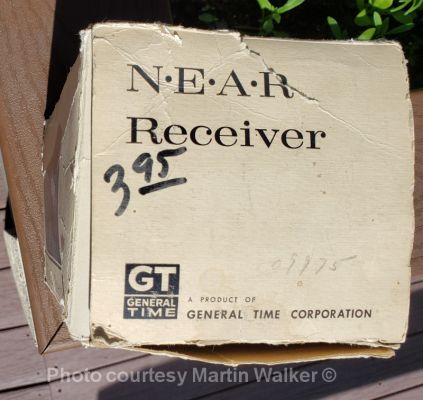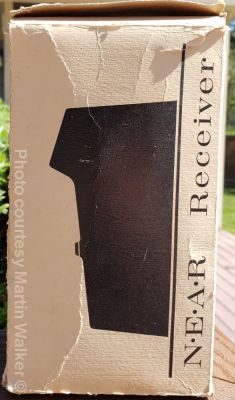The NEAR Project / Near Receiver
November 2010. It's about time I put this page up on the site. I've had a couple of NEAR receivers in my collection for a number of years now so this page is long overdue. The only information I have on the NEAR project is what I have found in the Civil Defense Annual Reports and a NEAR pamphlet. Here are a few photos of NEAR receivers and exceprts from the Civil Defense annual reports along with a link to a PDF file of the NEAR pamphlet. The first mention I found of a "home warning device" was in the 1954 FCDA Annual Report. I am missing a few of the annual reports from 1959 to 1963 so there's a bit of gap in the info. From what I found in the annual reports it appears that by 1963 CD was leaning towards a radio indoor warning system because it would be more cost effective in the long run. The annual reports mention field tests but I don't have any information on where those were conducted.
There were at least three models of the NEAR receiver produced that I have seen. The two models shown on this page and the model 2 receiver shown in the NEAR pamphlet linked to below. The model 2 receiver was manufactured by the AC Spark Plug Division of General Motors. The model 2 receiver can be seen in the PBS History Detectives Episode about the NEAR receiver which should still be available online.
 NEAR Receiver Model 105-1 Manufactured By RBM Controls Division, Essex Wire Corp. Logansport, Ind. |
 NEAR Receiver Model 105-1 Manufactured By RBM Controls Division, Essex Wire Corp. Logansport, Ind. |

NEAR Receiver Model CR155A3
Manufactured By General Electric.
I've had this for years and it remains unopened.
GE NEAR Receiver Photos By Victor Lee
Victor Lee e-mailed me in March 2018 about the NEAR receiver and was kind enough to
take photos of the GE model that he has since I never opened the one I have. Below are the
photos Victor sent of his receiver.
Click Photos To See Larger.
 |
 |
 |
 |
General Time Corporation NEAR Receiver Photos By Martin Walker
Martin Walker e-mailed me in June 2024 about a NEAR receiver he has which is a model made by General Time Corporation.
Martin sent photos and I have never seen this model before. Thanks Martin! Below are the photos Martin sent of
photos Martin sent of his receiver.
Click Photos To See Larger.
 |
 |
 |
 |


Here is a good quality scan of an original OCDM NEAR pamphlet.
NEAR Pamphlet PDF File
Click to download the file. 6Mb File Size
Excerpts From Civil Defense Annual Reports.
1954 First Annual Report Mention Of A "Home Warning Device"1954 - FCDA Annual Report Warning And Communications, Nationwide Attack Warning System Page 60
In the past year efforts were increased to develop a practicable home warning device. This is a necessary supplement to the public warning systems in order that warning can reach all homes at the earliest possible moment. Through the cooperation of a private corporation, a demonstration device has been developed and a survey made of three cities to determine the economics of a citywide installation. Suggestions from companies and private citizens have been carefully evaluated and some are being further investigated.
1955 - FCDA Annual Report Page 19 Home Warning DevicesSeveral studies have indicated the need to supplement the outdoor siren system with some internal warning devices the reach a maximum number of people. There are three methods by which this might be accomplished. The first would make use of sending a signal over a powerline either by momentary change of voltage or by supermimposing a signal over the standard cyclic rate. The second would transmit a signal over a telephone line and the third would make use of the CONELRAD system to transmit the signal by radio. In each instance the transmitted signal would trigger an alarm device within the home which would be attached either to to the powerline, telephone, or radio. Several contrats have been let to initialing research and development work to produce a feasible and economical home warning device. Other studies have been undertaken for the purpose of reviewing, analyzing, and recommending improvement for the entire civil defense warning and communications system.
1956 - Details Of The Home Warning Device Projects And Contractors1956 FCDA Annual Report Page 31
The 1956 Annual Report lists the projects and contractors for Home Warning Devices. In the "Projects In Progress" table.
| Starting Date | Project and Contractor | Scheduled Completion Date | FCDA funds obligated fiscal year 1956 |
| Home Warning Devices: A. Superimposed Powerline Signal Systems: |
|||
| December 1955 | 1. Powerline Harmonic System-Midwest Research Institue. Research on a voltage reduction signal system to be used on electric power distribution systems. The original voltage dip system has been found to have technical and practical difficulties. Eight different types of signals have been explored. The original scope of the contract has been revised and extended, and present emphasis is on a harmonic voltage system. | October 1956 | $49,883 |
| April 1956 | 2. Overall Investigation-Armour Research Foundation.- An overall study of powerline warning systems making use of superimposed signals over a wide range of frequencies. It will cover the general properties of warning systems and the generation and transmission of the warning signal. It will include comparitive study of home warning devices presently developed or being considered, as well as the preliminary design of a warning system based on the optimum superimposed signal. | ...do... | $39,557 |
| ...Do... | 3. Prototype 2000 Cps System-International Business Machines Corp.- Development of an internal warning system for the purpose of generating and receiving a civil defense alert signal. The contractor will furnish FCDA with receivers and necessary transmitting equipment for installation. | ...do... | $39,289 |
| May 1956 | 4. Hom-A-Lert System-Allis Chalmers Co.-Development, production and testing of an internal warning system including generating equipment, wave-trap equipment, and signal receivers to be installed and tested in Cincinnati. | September 1956 | $47,276 |
1957 First Annual Report With The NEAR Acronym with little information.
FCDA 1957 Annual Report Page 26 Research And Program Development, Research Projects section.
11. National Emergency Alarm Repeater (NEAR) Sytem, Midwest Research institute. Development of the NEAR system of internal warning by superimposing a harmonic voltage signal on electrical power distribution system.
1958 FCDA Annual Report, Mentions A Large Power Network NEAR Field Test.FCDA 1958 Annual Report Page 27 Research, Warning and Communications section.
2.Powerline Warning System.- The Midwest Research Institute of Kansas City, Mo., is developing a National Emergency Alarm Repeater powerline warning system which can transmit a nationwide warning to users of electric power who have a special warning receiver. At the end of the fiscal year a field test was underway on a large power network to determine the best methods for generating the warning signal. Several prototype warning receivers will be tested to develop a reliable, inexpensive receiver that may be plugged into any ordinary 110-volt alternating current outlet.
--I Have No CD Annual Reports Between 1959 to 1963.--1964 DOD OCD Annual Report, The End Of The NEAR Project.
1964 DOD OCD Annual Report Complementary Civil Defense Systems, Civil Defense Warning, Federal Warning Systems sectionPage 34
Indoor Warning Systems.-During fiscal year 1964, attention was focused upon developing a radio warning system that would
immediately alert the public of impending attack. Several reasons prompted this decision. Restrictions on broadcasting in times
of emergency had been lifted by discontinuance of CONELRAD (Control of Electromagnetic Radiation). Recent research studies
indicated that modification of existing radio transmitters or erection of new ones required for a radio warning sytem would be less
costly than installation of special signal generating equipment required to operate the National Emergency Alarm Repeater
(NEAR) system using electric utility lines. In additon, it was concluded that reduction in prices of radio components would make possible
the obtaining of radio receivers for this purpose at approximately the same cost of NEAR receivers. Accordingly, OCD made
contractural arrangements providing for evaluation of data affecting design fo radio warning systems and for developing radio
transmitters and recievers adapted to operational requrements of these systems.
Page 35
Contingent upon future appropriation of funds, OCD will complete engineering and development and testing of AM receivers,
signal transmission devices, and radio warning systems. As a result of these developments, contracts for analyzing 170 electric
utility systems for installation of the NEAR warning system were terminated. However, upon completion of systemwide NEAR tests,
underway in Michigan during calendar year 1964, basic engineering data required for installing the system will be available;
prototype NEAR components and installations have been proved technologically satisfactory.
DOC OCD Publication MP-30 Civil Defense 1965 Page 23-24
The outdoor public alerting aspect of the warning system limits its effectiveness,
and for several years studies been conducted to develop a practical indoor warning
system. At first, major emphasis was placed on development of the National Emergency
Alarm Repeater (NEAR) system which would use electric powerlines to transmit a signal.
However, studies conducted by OCD since 1963, after the discontinuance of CONELRAD
restrictions on radio broadcasting in time of national emergency, showed indoor radio
warning systems may prove highly attractive on the basis of cost an coverage.
In 1965, OCD intends to complete engineering field studies on both powerline and radio warning sytems to permit a basic decision on the deployment of an indoor warning system.
